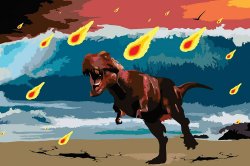Asteroid Impact that Killed Dinosaurs Triggered ‘Mega-earthquake’ that Lasted Months
Montclair PhD candidate presents evidence of new findings at Geological Society of America’s Annual Conference
Posted in: Homepage News, Press Releases, Research, Science and Technology

When the 6-mile-wide asteroid that led to dinosaur extinction hit Earth 66 million years ago, the impact also triggered a “mega-earthquake” that lasted weeks to months, new evidence suggests.
The magnitude of the impact released energy about 50,000 times more than was released in the magnitude 9.1 Sumatra earthquake in 2004. It was enough to generate gigantic earthquakes, mega-tsunamis and form a crater of 111 to 125 miles in diameter in the Yucatan Peninsula.
Hermann Bermúdez, a PhD candidate in the Environmental Science and Management program at Montclair State University, made the discovery while collecting data in the outcrops of the famous Cretaceous-Paleogene (K-Pg) mass extinction event boundary in Texas, Alabama and Mississippi earlier this year, supplementing his previous work in Colombia and Mexico.
Bermúdez presented the findings, titled “The Chicxulub Mega-Earthquake: Evidence from Colombia, Mexico, and the United States” at the 2022 Geological Society of America Connects conference in Denver earlier this month. The nonprofit organization supports and creates geoscience research opportunities to help solve Earth’s challenges.
While doing fieldwork on Colombia’s Gorgonilla Island in 2014, Bermúdez found layers of sediment filled with small glass beads (spherule deposits) and shards known as tektites and microtektites that were ejected into the atmosphere during the asteroid impact.
The rocks exposed on the coast of Gorgonilla Island tell a story from the bottom of the ocean. There, about 3,000 kilometers southwest from the site of the impact, sand, mud and small ocean creatures were accumulating on the ocean floor when the asteroid hit.
Layers of mud and sandstone as far as 10–15 meters below the sea floor experienced soft-sediment deformation that is preserved in the outcrops today, which Bermúdez attributes to the shaking from the impact. Faults and deformation due to shaking continue up through the spherule-rich layer that was deposited post-impact, indicating that the shaking must have continued for the weeks and months it took for these finer-grained deposits to reach the ocean floor. Just above those deposits, preserved fern spores signal the first recovery of plant life after the impact.
“The section I discovered on Gorgonilla Island is a fantastic place to study the K-Pg boundary,” Bermúdez says, “because it is one of the best-preserved and it was located deep in the ocean, so it was not affected by tsunamis.”
Evidence of deformation from the mega-earthquake is also preserved in Mexico and the United States. In Mexico, Bermúdez observed evidence of liquefaction – when strong shaking causes water-saturated sediments to flow like a liquid. In Mississippi, Alabama and Texas, Bermúdez documented faults and cracks likely associated with the mega-quake. He also documents tsunami deposits at several outcrops, left by an enormous wave that was part of the cascading catastrophes resulting from the asteroid collision.
Bermúdez conducted this research with financial support from a GSA Graduate Student Research Grant and the National Science Foundation; other authors on the investigation include Earth and Environmental Studies Assistant Professor Ying Cui, Earth and Environmental Science master’s student Maura De Palma and institutions such as University of Texas at Austin and the National Autonomous University of Mexico.
“Hermann is an excellent geologist in our Environmental Science and Management PhD program,” Cui says. “His research on the sedimentological structures of the K-Pg rock sequences from the U.S., Mexico and Colombia provides first-hand evidence for the mega-earthquake that occurred after the asteroid impact 66 million years ago. He is an extremely valuable addition to the talent in the Earth and Environmental Studies program, and we are super proud of his work.”
To learn more about the Environmental Science and Management PhD program, visit https://www.montclair.edu/environmental-management-phd/.
